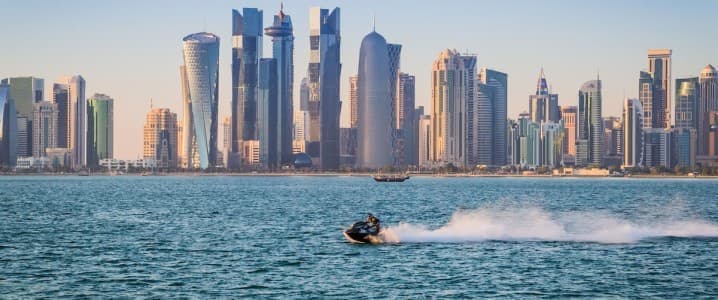
On 9 September, Israel attacked Qatar, a U.S. ally that was hosting a Hamas delegation that was considering a peace proposal from U.S. President Donald Trump. Israel killed three low-ranking officials, a child of a delegation member, and a Qatari security officer. The targeted officials survived.
The White House claimed Trump wasn’t notified in advance by Israel and learned of the attack from the Pentagon, though Israeli sources claim he was notified in advance. Trump ordered his crisis negotiator, Steve Witkof,f to alert Doha, but Witkoff’s call came too late.
The attack and Trump’s casual reaction underlined what Al-Akhbar called “The Myth of US Guarantees” and highlighted a world where some American allies are “more equal than others.”
In the Middle East, Bahrain, Egypt, Israel, Jordan, Kuwait, Morocco, New Zealand, Qatar, and Tunisia are Major Non-NATO Allies which used to mean something. America isn’t leaving the Middle East, but the first order of business for its Gulf Cooperation Council (GCC) allies is how to “de-risk” the American relationship and work towards “strategic diversification.”
First, find new partners. The U.S. stood aside when Israel attacked Qatar, so the tens of billions of dollars to U.S. defense contractors, and the free use of military bases, were for nothing when it counted, so the region should supplement the U.S. relationship.
Related: Iraq Expects Kurdistan Oil Exports to Restart This Week
We saw the first instance with the Saudi Arabia-Pakistan defense pact that makes Islamabad’s nuclear capabilities available to the kingdom, and other petrostates may soon follow suit. Pakistan is the “P” in CPEC, the China-Pakistan Economic Corridor, Beijing’s US$65 billion regional connectivity project. China is already Pakistan’s top arms supplier, so the defense pact will provide Islamabad with access to Chinese technology and Saudi money.
On an ironic note, King Faisal of Saudi Arabia was a staunch opponent of communism, and a successor, Fahd, carried forward that policy and supported the Afghan mujahedin in their fight against the Soviet forces. The current (de facto) ruler of the kingdom, Muhammad bin Salman, is now in an alliance with China’s Communist Party, though at a remove, via Pakistan. And in 2024, Saudi Arabia accounted for almost 10% of China’s total crude oil imports, making it a leading supplier to Beijing.
Other potential partners are China, Russia, Turkey, and Egypt. Russia is busy now, but China will welcome the opportunity to fill a vacuum. Beijing is cautious in military engagements (an early test will come in Iran, also after Israeli attacks) but it is the world’s technology leader and is known to the region’s leaders for its Belt and Road Initiative investments, particularly the Digital Silk Road, which integrates Artificial Intelligence and new technologies.
And unlike the U.S. or Europe, Beijing takes a “hands off” approach to local governance and social models. China is run by communists, but it isn’t exporting communism.
The new U.S. National Defense Strategy may emphasize the security of the western hemisphere with less emphasis on Russia and the “China threat.” If the Trump administration is taking its eyes off China, the Middle East is not far behind, though the U.S. will keep its commitment to provide for Israel’s defense. Everyone else is on their own.
In response to the Israeli attack, Turkey and Egypt held their first naval exercises in 13 years; Egypt has revived the idea of the “Arab NATO;” Iran has called for an “Islamic NATO”; and Hezbollah has made a peaceful overture to Saudi Arabia. Interesting times, indeed.
In early 2025, Egypt hosted the “Eagles of Civilization 2025,” the largest Sino-Egyptian bilateral military exercise ever, and coming just months ahead of the Bright Star 25 exercises with the U.S. and NATO countries. Egypt is already hedging and the GCC members may decide Cairo is taking a prudent path.
Second, take a “Make or Buy” decision. The Gulf countries have been big customers for U.S. military goods ever since the Shah of Iran saved the American Grumman Aerospace Corporation and the F-14 “Tomcat” fighter aircraft. The countries should diversify their defense purchases and consider making more items locally, using the Americans’ defense offset obligations to fund local technology manufacturing capability with the goal of becoming subcontractors to the American prime contractors.
According to the U.S. Department of Commerce, in 2022 “U.S. defense contractors reported entering into 27 new offset agreements with 13 countries valued at $5.88 billion.” A big piece of that obligation is with Gulf countries and it would be an excellent way to prime the pump for local manufacturing and supply chain surety.
Saudi Arabian Military Industries (SAMI) and EDGE Group (United Arab Emirates) – the latter recently sponsored the Make it in the Emirates forum – can be the kernel of a stronger local defense industrial base. Turkey is a potential partner as its drones have performed well in Ukraine and the ANKA-3 stealth drone and TALAY sea-skimming drone may bring new capabilities to the region.
Iran and the GCC are improving relations, most notably by Saudi Arabia and Qatar, though engagement hiccupped when Iran attacked the U.S. airbase at al-Udeid, Qatar. This may be the time for the Gulf Arabs to maintain the momentum of engagement, though any technology transfer with Iran will be used by the U.S. as justification to blunt economic growth by sanctioning GCC companies. Sanctions on domestic production will make the GCC more reliant on the U.S. contractors, who will throw in a price hike, to boot.
The Gulf countries should demand 100% supply chain visibility from the U.S. vendors so they know what they are buying and from whom, though it is likely the U.S. has installed backdoors for surveillance and disabled any ability to defend against Israeli aircraft or missiles. If the Gulf countries buy more Chinese gear, the Chinese will also be snooping, but at least they won’t be buying from a vendor that will limit their ability for self-defense.
Last, sponsor a regional air defense net. The Persian Gulf is home to some of the world’s most strategically valuable infrastructure, such as oil export terminals; liquefied natural gas facilities; petrochemical plants; major ports and maritime hubs, such as Jebel Ali Port (UAE) and King Abdulaziz Port (Saudi Arabia); strategic maritime corridors, such as the Strait of Hormuz; airspace corridors used by airlines flying between Europe, Asia, and the Middle East; major air hubs at Doha and Dubai; and road and rail links and Special Economic Zones.
And China has a wide array of air defense systems for strategic and long-range targets, mid-range and tactical engagements, for short-range & point defense, and counter-drone defense.
The Gulf countries (this includes Iran) should assume that Israel will attack again, and the Americans won’t stop Israel or alert them. China relies on the Gulf for a significant amount of hydrocarbons. Iran provides about 1.4 million barrels per day of oil to China, and Saudi Arabia, Iraq, the UAE, and Kuwait also supply China. Tehran is defiant in the face of snapback sanctions by France, Germany, and the UK and has vowed to continue sending oil to China.
The region needs new partners, and it may be time for China to take a more active role in protecting its energy lifeline while it dilutes American influence in the world’s key energy hub. China may find it is pushing on an open door.
By James Durso for Oilprice.com
More Top Reads From Oilprice.com
Why Iraq Wants Solar Despite Centuries of Oil Reserves
Petrobras Clears Key Hurdle for Amazon Drilling
Eni Sells 30% in Cote d’Ivoire Oil and Gas Project to Top Trader



